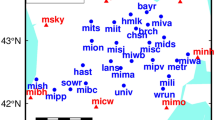Abstract
Ionospheric delay is the most important environmental factor affecting the positioning performance of single-frequency precise point positioning (SF-PPP). If external ionospheric information is introduced and the weight of ionospheric pseudo-observation is reasonably set, positioning performance can be improved. In this paper, the stochastic model of ionospheric-constrained (IC) SF-PPP, as well as the positioning performances of ionospheric-unconstrained (IU) SF-PPP, ionospheric-free (IF) SF-PPP and IC SF-PPP models were studied. Multi-Global Navigation Satellite System (GNSS) observations of 42 stations from the Multi-GNSS Experiment (MGEX) for 7 days were processed. Firstly, the four classical stochastic models of IC SF-PPP were optimized based on the posterior residual correction (PRC) method. The results show that the PRC method has the highest positioning accuracy improvement (42.4%, 51%, and 56.1%) in the east, north, and up (E, N, U) directions on the IC model. The positioning accuracy results of the IC SF-PPP model using the optimal stochastic model in the E, N, and U directions are 59.8, 42.1 and 31.2% higher than those of the IU SF-PPP model for a one-day period. Second, the short-term positioning performances of three SF-PPP models were compared. The experiments show that the IU SF-PPP model has higher positioning accuracy than the IF model, but the convergence performance is opposite. The IC model has the best positioning performance, especially in dynamic mode. In addition, the short-term positioning performance of IC model in E and N directions is slightly changed when adding multi-GNSS observations and does not differ much in static and dynamic modes. Therefore, IC model using the improved stochastic model is the most cost-effective model for dynamic single-system users in SF-PPP.








Similar content being viewed by others
References
Abdelazeem M, Çelik R (2017) An improved regional ionospheric model for single-frequency GNSS users. Surv Rev 49:153–159
Avstedal O (2002) Absolute positioning with single-frequency GPS receivers. GPS Solutions 5(4):33–44
Cai C, Gong Y (2017) An approach to speed up single-frequency PPP convergence with quad-constellation GNSS and GIM. Sensors 17(6):1302
Cai C, Liu Z (2013) Single-frequency ionosphere-free precise point positioning using combined GPS and GLONASS observations. J Navig 66(3):417–434
Choy S, Bisnath S (2017) Uncovering common misconceptions in GNSS precise point positioning and its future prospect. GPS Solutions 21(1):13–22
Feltens J (2003) The international GPS service (IGS) ionosphere working group. Adv Space Res. D. Bilitza, K. Rawer and B. W. Reinisch. KIDLINGTON, PERGAMON-ELSEVIER SCIENCE LTD 31:635–644
Geng J, Teferle FN (2010) Kinematic precise point positioning at remote marine platforms. GPS Solutions 14(4):343–350
Guo F, Li X (2017) Assessment of precise orbit and clock products for Galileo, BeiDou, and QZSS from IGS multi-GNSS experiment (MGEX). GPS Solutions 21(1):279–290
Lejeune S, Wautelet G (2012) Ionospheric effects on relative positioning within a dense GPS network. GPS Solutions 16(1):105–116
Li S, Li L (2017) Comparative analysis of three ionospheric broadcast models for global navigation satellite systems. Acta Geophys 65(2):1–16
Li P, Zhang X (2014) Integrating GPS and GLONASS to accelerate convergence and initialization times of precise point positioning. GPS Solutions 18(3):461–471
Liu T, Yuan Y (2017) Multi-GNSS precise point positioning (MGPPP) using raw observations. J Geod 91(3):253–268
Lou Y, Zheng F (2016) Multi-GNSS precise point positioning with raw single-frequency and dual-frequency measurement models. GPS Solutions 20(4):849–862
Ning Y, Han H (2018) Single-frequency precise point positioning enhanced with multi-GNSS observations and global ionosphere maps. Meas Sci Technol 30(1):15013
Sterle O, Stopar B (2015) Single-frequency precise point positioning: an analytical approach. J Geod 89(8):793–810
Sz A, Dy A (2021) Comparative analysis of four different single-frequency PPP models on positioning performance and atmosphere delay retrieval. Adv Space Res 67(12):3994–3401
Tu R, Ge M, Zhang H (2013) The realization and convergence analysis of combined PPP based on raw observation. Adv Space Res 52(1):211–221
Stankov SM,Warnant R (2009)Trans-ionospheric GPS signal delay gradients observed over mid-latitude Europe. Adv Space Res 43(9):1314–1324
Xiang Y, Gao Y (2017) Carrier phase-based ionospheric observables using PPP models. Geod Geodyn 8(1):17–23
Yunck TP (1993) Coping with the atmosphere and ionosphere in precise satellite and ground positioning. Environmental Effects on Spacecraft Positioning and Trajectories. American Geophysical Union, Washington, DC
Zang N, Li B, Shen Y (2017) Comparison and analysis of three GPS+BDS PPP models. Acta Geodetica et Cartographica Sinica 46(12):1929–1938
Zhang H, Gao Z (2013) On the convergence of ionospheric constrained precise point positioning (IC-PPP) based on Undifferential uncombined raw GNSS observations. Sensors 13(11):15708–15725
Zhang B, Teunissen PJG (2018) Joint estimation of vertical total electron content (VTEC) and satellite differential code biases (SDCBs) using low-cost receivers. J Geod 92(4):401–413
Zhu S, Yue D (2020) A formal dynamic stochastic model for single-frequency precise point positioning constrained by global ionosphere map. Meas Sci Technol 32(3)
Zumberge JF, Heflin MB, Jeferson DC (1997) Precise point positioning for the efficient and robust analysis of GPS data from large networks. J Geophys Res Solid Earth 102(B3):5005–5017
Acknowledgments
The research was supported by the State Key Laboratory of Geo-Information Engineering and Key Laboratory of Surveying and Mapping Science and Geospatial Information Technology of MNR, CASM (No. 2021-01-07).
Author information
Authors and Affiliations
Corresponding author
Ethics declarations
Conflict of interest
The authors declare that they have no conflict of interest.
Additional information
Communicated by: H. Babaie
Publisher’s note
Springer Nature remains neutral with regard to jurisdictional claims in published maps and institutional affiliations.
Rights and permissions
About this article
Cite this article
Shen, H., Li, S., Li, L. et al. Evaluation of ionospheric-constrained single-frequency PPP enhanced with an improved stochastic model. Earth Sci Inform 15, 1671–1681 (2022). https://doi.org/10.1007/s12145-022-00827-2
Received:
Accepted:
Published:
Issue Date:
DOI: https://doi.org/10.1007/s12145-022-00827-2




